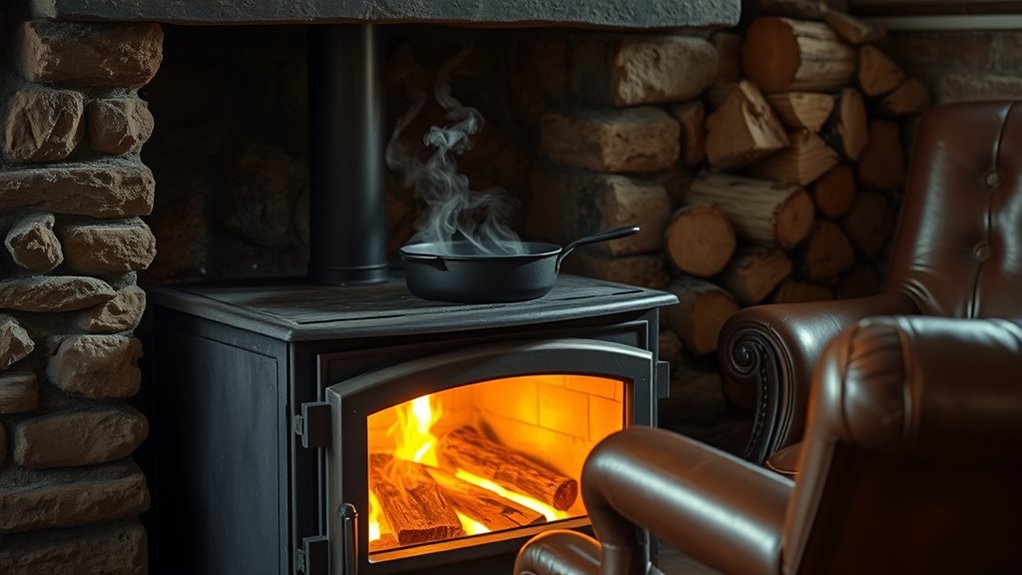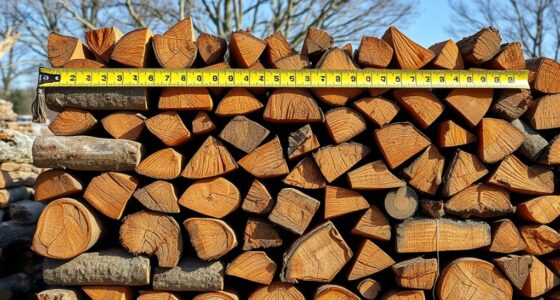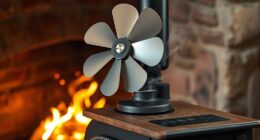To control humidity when heating with wood, monitor indoor moisture levels with a hygrometer and maintain them between 30-50%. Use humidifiers if air gets too dry, and dehumidifiers or ventilation if it gets too humid. Properly store and season your wood to reduce excess moisture. Sealing drafts and controlling airflow helps improve temperature and humidity balance. Keep these tips in mind, and you’ll discover more ways to keep your indoor climate comfortable.
Key Takeaways
- Monitor indoor humidity with a hygrometer and aim for 30-50% for comfort and safety.
- Ventilate strategically during warm periods to balance humidity and heat retention.
- Store and season wood properly to prevent excess moisture and humidity fluctuations.
- Use humidifiers or dehumidifiers to maintain consistent moisture levels year-round.
- Seal gaps, insulate, and optimize airflow to reduce heat loss and stabilize indoor humidity.
Understanding Humidity Changes During Wood Burning

When you burn wood, the humidity levels in your home can fluctuate considerably. As the fire ignites, it consumes moisture from the wood, releasing water vapor into the air. This process temporarily increases indoor humidity, making the air feel damp or muggy. However, as the fire continues to burn and the wood dries out, the overall moisture content decreases, leading to a drop in humidity. Additionally, heat from the fire causes warm air to rise and escape, potentially pulling in drier air from outside or other parts of your home. These shifts happen rapidly, especially with frequent or intense fires. Recognizing these natural humidity fluctuations helps you anticipate changes and maintain a comfortable indoor environment. Understanding indoor air quality and humidity dynamics can help you better control your home’s climate during wood heating. Implementing proper ventilation practices can further stabilize indoor conditions and improve overall comfort. Being aware of moisture management techniques can also minimize negative effects on your health and home structure. Incorporating a hygrometer allows you to monitor humidity levels more precisely, making adjustments easier.
Monitoring Indoor Humidity Levels Effectively

To keep your indoor humidity balanced, make a habit of using hygrometers regularly. Adjust your ventilation based on the readings to prevent the air from becoming too dry or too damp. Consistent monitoring helps you maintain a comfortable and healthy environment while heating with wood. Being aware of indoor humidity levels can also help prevent mold growth and maintain your home’s structural integrity. Proper humidity levels can also reduce airborne pollutants, making your home safer and more comfortable. Incorporating lifestyle adjustments such as managing your heating habits can further optimize indoor air quality. Additionally, understanding the proper use of humidifiers and dehumidifiers can help maintain ideal humidity levels throughout different seasons. Implementing data-driven strategies can ensure your humidity control methods are effective and evidence-based.
Use Hygrometers Regularly
Regularly using hygrometers is essential for maintaining the right indoor humidity levels when heating with wood. These devices help you monitor moisture levels accurately, preventing issues like mold or dry air. Check your hygrometer daily, especially during peak heating months, to ensure humidity stays between 30-50%. If levels are off, you can adjust by adding or removing moisture sources accordingly. Here’s a quick overview:
| Humidity Level | Action |
|---|---|
| Below 30% | Use a humidifier or water bowls |
| 30-50% | Ideal range, maintain current setup |
| Above 50% | Increase ventilation or use a dehumidifier |
| Critical | Take immediate steps to reduce moisture |
Staying vigilant with hygrometers helps keep your home comfortable and healthy during wood heating. Monitoring indoor humidity levels effectively ensures a safe and cozy environment. Regularly checking your indoor climate control allows you to respond promptly to humidity fluctuations. Maintaining proper humidity also supports the efficiency of your air quality management, ensuring healthier air in your living space.
Adjust Ventilation Strategically
Monitoring your indoor humidity levels with a hygrometer is only part of maintaining a comfortable environment when heating with wood. To truly control humidity, you need to adjust your ventilation strategically. If the air feels too dry, increase airflow by opening windows briefly or using exhaust fans to introduce more moisture. Conversely, if humidity is too high, reduce ventilation or keep windows closed to trap moisture inside. Proper timing is key—ventilate during the warmest parts of the day or after a fire to balance humidity levels without losing too much heat. Remember, consistent, targeted ventilation helps stabilize indoor humidity, preventing issues like mold or dry skin. Additionally, understanding regional climate factors can help you better tailor your ventilation strategies to your specific area. Being aware of seasonal variations can also aid in adjusting your approach throughout the year. Fine-tuning your ventilation ensures a healthier, more comfortable space when heating with wood, especially by managing indoor air quality effectively. Proper ventilation timing can further optimize both heat retention and humidity control, making your space more comfortable year-round. Incorporating smart ventilation techniques can further enhance your ability to maintain ideal humidity levels efficiently.
Using Humidifiers to Add Moisture When Needed
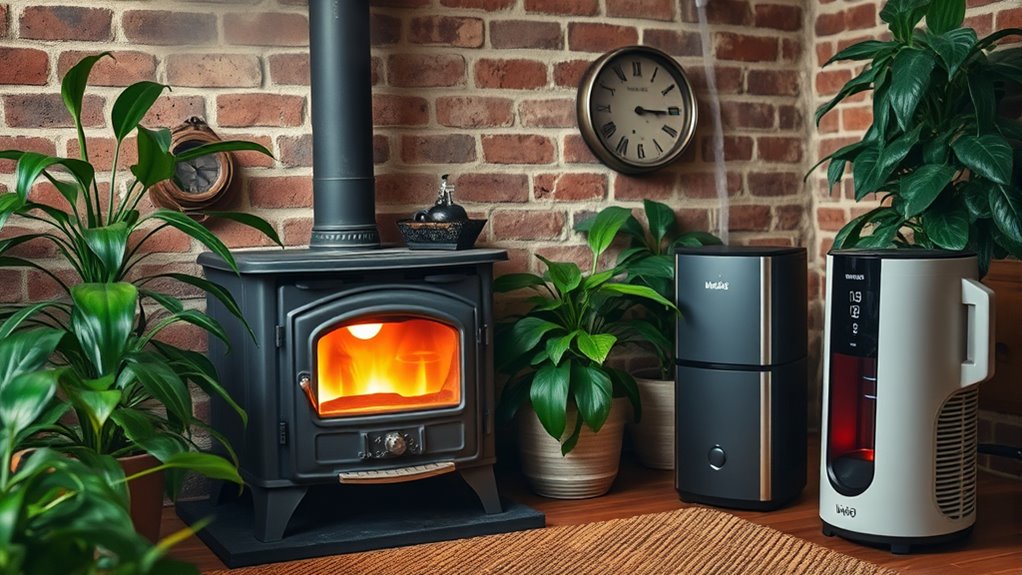
When heating with wood, indoor air can quickly become dry, leading to discomfort and potential health issues. To combat this, using a humidifier can help restore moisture levels. Place a humidifier in common living areas or bedrooms to add humidity gradually. Make sure to select the right size for your space and keep it clean to prevent mold and bacteria growth. Regularly check the humidity level with a hygrometer, aiming for around 40-50%. Fill the humidifier with clean, distilled water to avoid mineral buildup. Running it during the coldest parts of the day or when indoor air feels especially dry ensures you maintain a comfortable environment. Proper use of humidifiers balances moisture, reducing dryness-related issues and making your home more comfortable during wood heating.
Incorporating Dehumidifiers to Reduce Excess Moisture
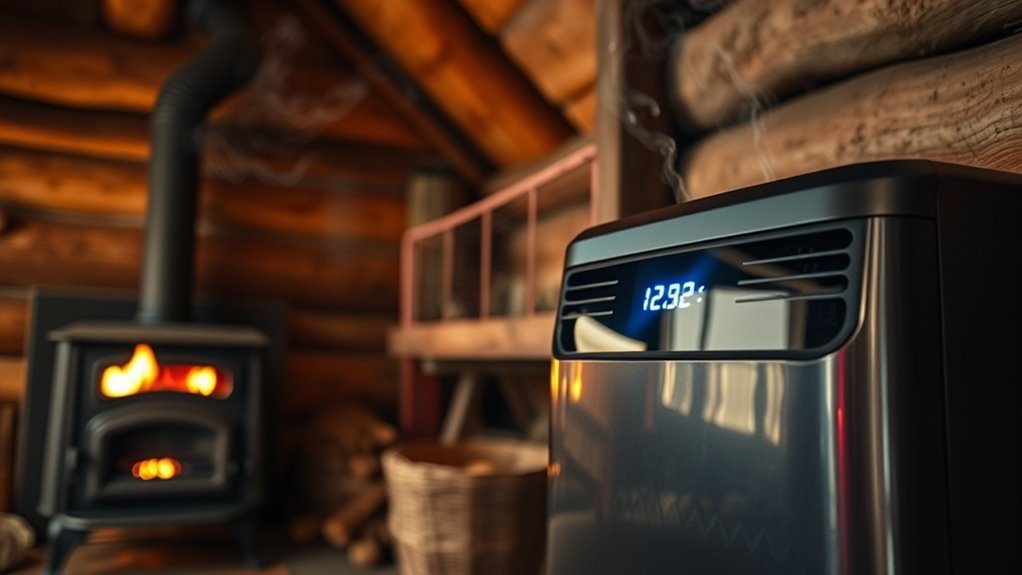
While heating with wood can dry out indoor air, there are times when excess moisture becomes a problem, especially in poorly ventilated spaces. High humidity can lead to mold growth, musty odors, and wood rot. To combat this, incorporating a dehumidifier can be effective. Choose a unit with enough capacity for your space and set it to maintain ideal humidity levels—around 40-50%. Place the dehumidifier in a central location for even moisture removal. Regularly empty the water reservoir and clean the filter to keep it functioning efficiently. Using a dehumidifier helps control excess moisture without over-drying the air, creating a more comfortable and healthier environment. It’s a practical solution for managing humidity, especially during extended heating seasons when moisture issues are more likely.
Ventilation Strategies for Optimal Moisture Balance
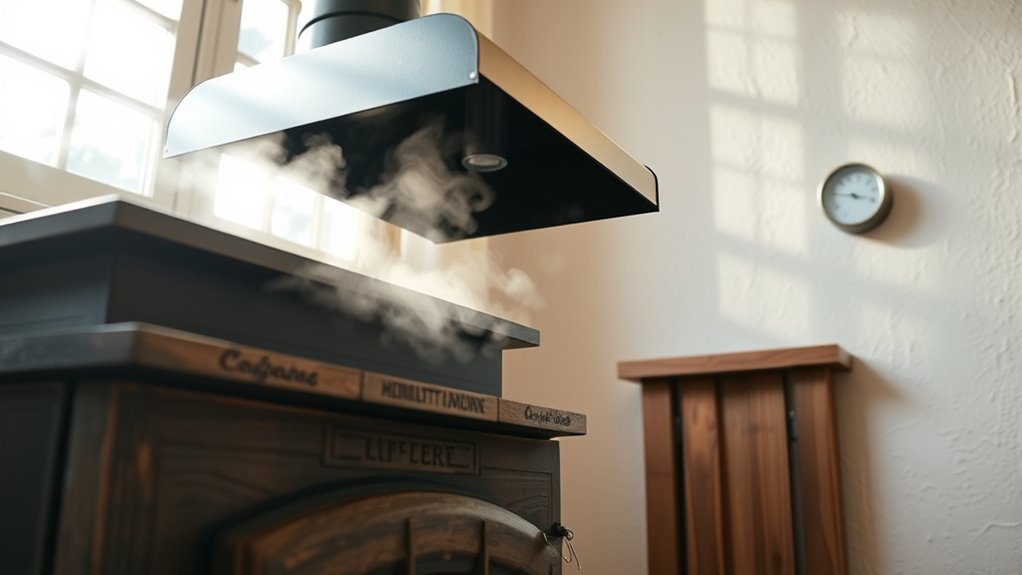
Effective ventilation is essential for maintaining the right moisture balance when heating with wood. Proper airflow helps prevent excess humidity from lingering, which can lead to mold and dampness. To achieve this, open vents or windows slightly during and after heating, especially in high-humidity environments. Use exhaust fans in areas like kitchens and bathrooms to remove moist air efficiently. Consider installing a heat recovery ventilator (HRV) or energy recovery ventilator (ERV) to exchange stale indoor air with fresh outdoor air while conserving heat. Regularly monitor indoor humidity levels with a hygrometer to ensure they stay within the ideal 30-50% range. Adjust your ventilation based on seasonal changes and indoor activity, keeping air circulating without causing drafts or heat loss. Proper ventilation is key to balancing moisture and maintaining a comfortable, healthy home.
Proper Wood Storage and Drying Techniques
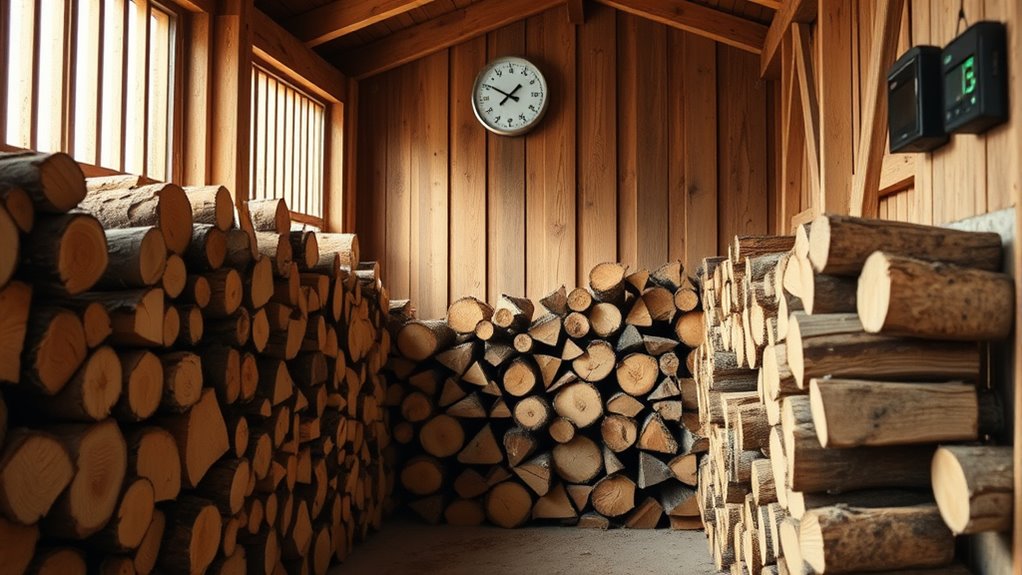
Proper wood storage and drying are crucial to guarantee your firewood burns efficiently and produces less smoke. To do this, store your wood in a dry, well-ventilated area off the ground, preferably stacked in a crisscross pattern to promote airflow. Cover the top of the stack with a waterproof tarp, but leave the sides exposed to allow moisture to escape. Use seasoned wood, which has been dried for at least six to twelve months, with a moisture content below 20%. Avoid storing wood indoors or in humid areas, as excess moisture hampers combustion and increases smoke. Proper drying reduces creosote buildup, enhances heat output, and makes your heating more efficient overall. Regularly check the moisture level with a moisture meter to ensure your wood remains properly seasoned.
Sealing Drafts and Insulation for Better Climate Control
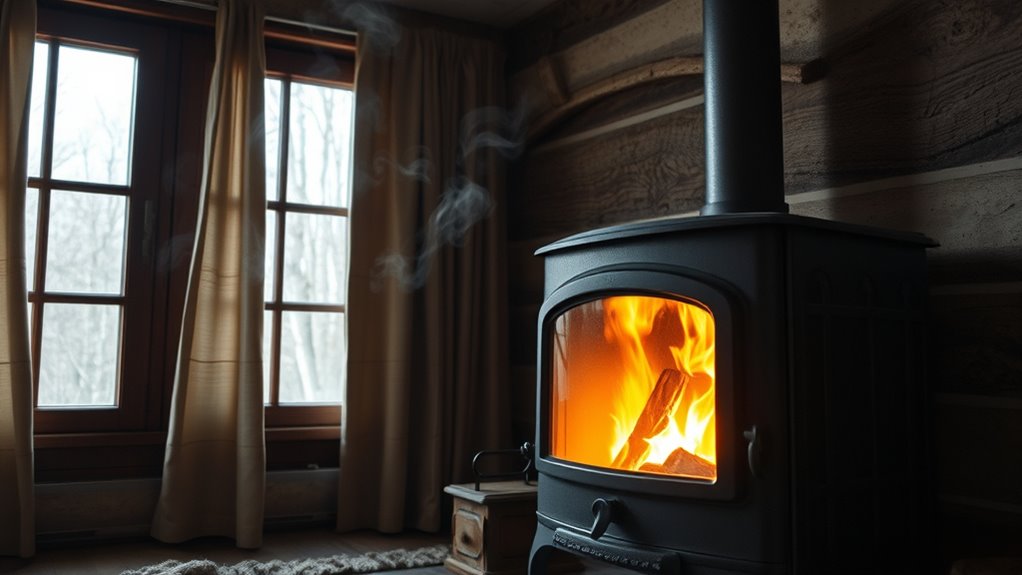
Sealing drafts and improving insulation can substantially boost your heating efficiency when using a wood stove. Gaps around windows, doors, and outlets let warm air escape and cold air enter, making it harder to maintain a consistent indoor climate. To fix this, seal leaks with weatherstripping or caulk. Adding insulation to walls, attic, and floors helps retain heat longer. Consider weatherproofing your windows with draft stoppers or thermal curtains. Proper insulation reduces heat loss, allowing you to lower your stove’s setting while keeping your space warm and comfortable. These measures not only improve energy efficiency but also help control indoor humidity levels. A well-sealed and insulated home creates a more stable environment, making your wood heating more effective and comfortable year-round.
Tips for Maintaining Healthy Indoor Conditions Year-Round
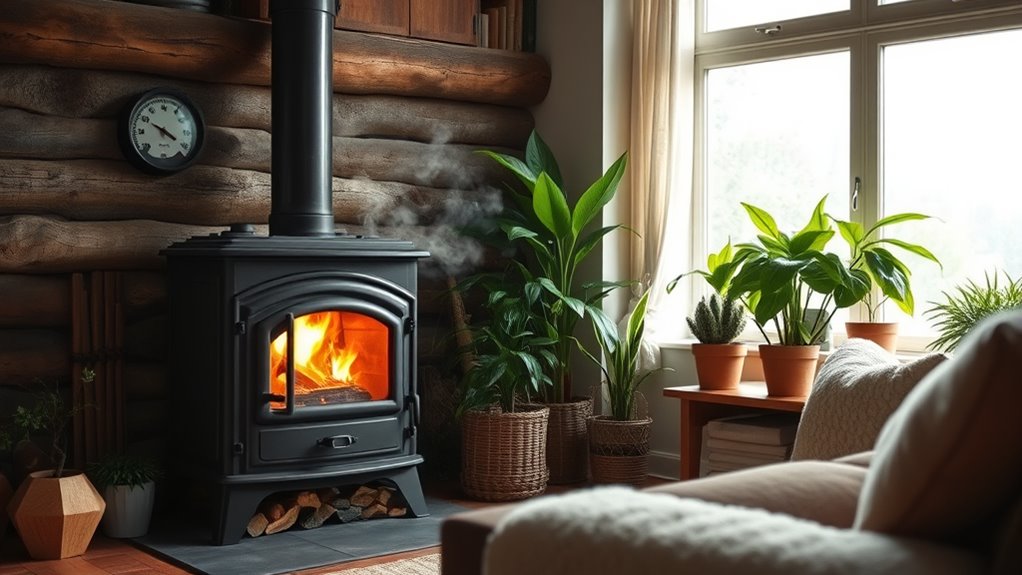
Maintaining healthy indoor conditions year-round requires consistent attention to humidity, air quality, and temperature. To do this, monitor humidity levels regularly with a hygrometer, aiming for 30-50%. Use a humidifier or dehumidifier as needed to balance moisture, especially during heating seasons when air tends to dry out. Keep your home well-ventilated to prevent stale air and reduce indoor pollutants. Regularly change filters and clean heating equipment to maintain good air quality. Adjust your thermostat to keep temperatures comfortable without over-drying the air. Incorporate houseplants that help regulate humidity naturally. By staying proactive with these practices, you’ll create a healthier, more comfortable environment regardless of the season.
Frequently Asked Questions
How Does Outdoor Humidity Affect Indoor Moisture Levels During Wood Heating?
Outdoor humidity impacts your indoor moisture levels, especially when you’re heating with wood. If the air outside is dry, it can draw moisture from your home, making indoor air even drier. Conversely, humid outdoor air can increase indoor humidity, potentially causing excess moisture problems. Keep an eye on outdoor conditions and use humidifiers or dehumidifiers as needed to maintain comfortable, balanced indoor moisture levels during your wood heating.
Can Specific Wood Types Influence Indoor Humidity When Burned?
You might not realize it, but the type of wood you burn can totally change your indoor humidity! Hardwoods like oak or maple release more moisture into the air, making your home feel damp or musty. Softwoods like pine dry out the air faster, leaving it dry and uncomfortable. So, choosing the right wood isn’t just about heat—it’s your secret weapon for perfect indoor humidity levels when heating with wood.
What Are the Health Risks of Improper Humidity Control With Wood Heating?
When you don’t control indoor humidity properly while heating with wood, you risk health issues like respiratory irritation, allergies, and worsened asthma. Low humidity can cause dry skin, sore throats, and increased susceptibility to colds. Excess moisture promotes mold growth and dust mites, which can trigger asthma and allergies. To stay healthy, maintain balanced humidity levels, guarantee proper ventilation, and monitor indoor air quality during your wood heating season.
Are There Eco-Friendly Methods to Regulate Indoor Moisture During Heating?
You can use eco-friendly methods to regulate indoor moisture during heating by opting for natural solutions. Keep houseplants, which naturally add humidity, and use bowls of water near heat sources to release moisture. Ventilate regularly to maintain balanced humidity levels and choose energy-efficient humidifiers made from sustainable materials. These approaches help you manage moisture effectively while minimizing environmental impact, ensuring a healthier and greener indoor environment during the heating season.
How Often Should Indoor Humidity Levels Be Checked in Winter?
Did you know that indoor humidity should ideally be between 30-50% for comfort and health? During winter, you should check your humidity levels at least once a week because heating can dry out the air quickly. If you notice it dropping below 30%, use a humidifier or moisture sources like houseplants or bowls of water to maintain a cozy, healthy environment. Regular checks help prevent dry skin and respiratory issues.
Conclusion
Keeping your home comfortable while burning wood is like walking a tightrope—you need to balance moisture carefully. By monitoring humidity levels, using humidifiers or dehumidifiers when needed, and ensuring proper ventilation and storage, you can create a cozy, healthy environment all year round. Think of it as tuning a fine instrument—each adjustment brings harmony to your indoor climate. Stay attentive, and your home will stay warm, inviting, and perfectly balanced.
